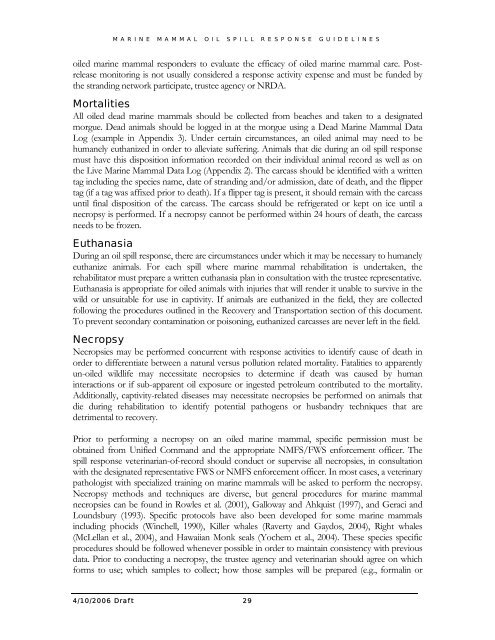Volume III, Appendices EM - National Marine Fisheries Service ...
Volume III, Appendices EM - National Marine Fisheries Service ...
Volume III, Appendices EM - National Marine Fisheries Service ...
Create successful ePaper yourself
Turn your PDF publications into a flip-book with our unique Google optimized e-Paper software.
MARINE MAMMAL OIL SPILL RESPONSE GUIDELINES<br />
oiled marine mammal responders to evaluate the efficacy of oiled marine mammal care. Postrelease<br />
monitoring is not usually considered a response activity expense and must be funded by<br />
the stranding network participate, trustee agency or NRDA.<br />
Mortalities<br />
All oiled dead marine mammals should be collected from beaches and taken to a designated<br />
morgue. Dead animals should be logged in at the morgue using a Dead <strong>Marine</strong> Mammal Data<br />
Log (example in Appendix 3). Under certain circumstances, an oiled animal may need to be<br />
humanely euthanized in order to alleviate suffering. Animals that die during an oil spill response<br />
must have this disposition information recorded on their individual animal record as well as on<br />
the Live <strong>Marine</strong> Mammal Data Log (Appendix 2). The carcass should be identified with a written<br />
tag including the species name, date of stranding and/or admission, date of death, and the flipper<br />
tag (if a tag was affixed prior to death). If a flipper tag is present, it should remain with the carcass<br />
until final disposition of the carcass. The carcass should be refrigerated or kept on ice until a<br />
necropsy is performed. If a necropsy cannot be performed within 24 hours of death, the carcass<br />
needs to be frozen.<br />
Euthanasia<br />
During an oil spill response, there are circumstances under which it may be necessary to humanely<br />
euthanize animals. For each spill where marine mammal rehabilitation is undertaken, the<br />
rehabilitator must prepare a written euthanasia plan in consultation with the trustee representative.<br />
Euthanasia is appropriate for oiled animals with injuries that will render it unable to survive in the<br />
wild or unsuitable for use in captivity. If animals are euthanized in the field, they are collected<br />
following the procedures outlined in the Recovery and Transportation section of this document.<br />
To prevent secondary contamination or poisoning, euthanized carcasses are never left in the field.<br />
Necropsy<br />
Necropsies may be performed concurrent with response activities to identify cause of death in<br />
order to differentiate between a natural versus pollution related mortality. Fatalities to apparently<br />
un-oiled wildlife may necessitate necropsies to determine if death was caused by human<br />
interactions or if sub-apparent oil exposure or ingested petroleum contributed to the mortality.<br />
Additionally, captivity-related diseases may necessitate necropsies be performed on animals that<br />
die during rehabilitation to identify potential pathogens or husbandry techniques that are<br />
detrimental to recovery.<br />
Prior to performing a necropsy on an oiled marine mammal, specific permission must be<br />
obtained from Unified Command and the appropriate NMFS/FWS enforcement officer. The<br />
spill response veterinarian-of-record should conduct or supervise all necropsies, in consultation<br />
with the designated representative FWS or NMFS enforcement officer. In most cases, a veterinary<br />
pathologist with specialized training on marine mammals will be asked to perform the necropsy.<br />
Necropsy methods and techniques are diverse, but general procedures for marine mammal<br />
necropsies can be found in Rowles et al. (2001), Galloway and Ahlquist (1997), and Geraci and<br />
Loundsbury (1993). Specific protocols have also been developed for some marine mammals<br />
including phocids (Winchell, 1990), Killer whales (Raverty and Gaydos, 2004), Right whales<br />
(McLellan et al., 2004), and Hawaiian Monk seals (Yochem et al., 2004). These species specific<br />
procedures should be followed whenever possible in order to maintain consistency with previous<br />
data. Prior to conducting a necropsy, the trustee agency and veterinarian should agree on which<br />
forms to use; which samples to collect; how those samples will be prepared (e.g., formalin or<br />
4/10/2006 Draf t 29
















